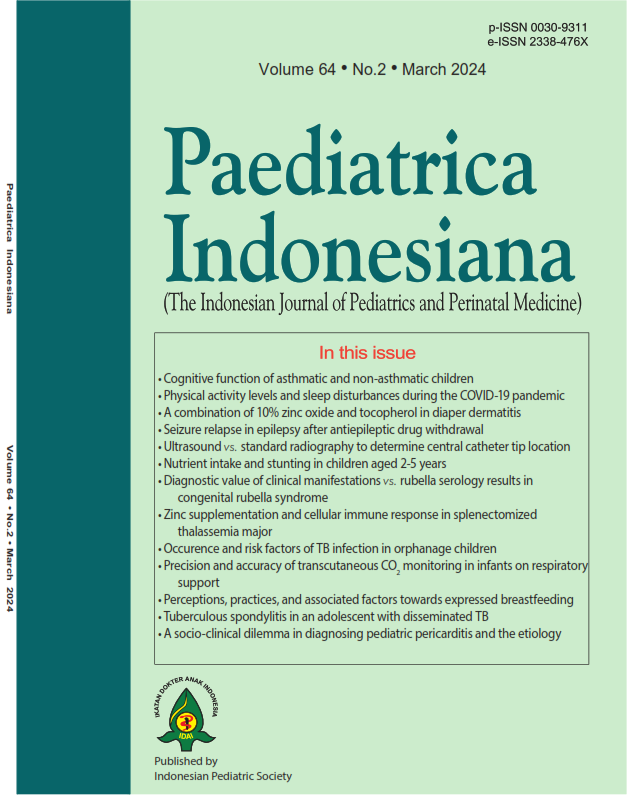Precision and accuracy of transcutaneous CO2 monitoring in infants born at 32-36 weeks of pregnancy on respiratory support
Abstract
Background Respiratory disorders in premature neonates often require respiratory support. Continous transcutaneous monitoring is an available non-invasive option to monitor CO2 pressure, substituting the need for blood gas analysis as the gold standard evaluation in practice. Most studies have been conducted on very and extremely preterm neonates, but rarely in late and moderately preterm neonates.
Objective To determine the precision and accuracy of transcutaneous CO2 pressure measuring devices compared to arterial blood gas analysis in neonates of 32-36 weeks gestational age who received respiratory support.
Methods This diagnostic, cross-sectional study was conducted on 35 late and moderately preterm neonates of 32–36 weeks gestation who received cardiopulmonary resuscitation (CPR) in the Neonatology Unit at Rumah Sakit Cipto Mangunkusumo, Jakarta. Subjects were monitored with a transcutaneous CO2 monitor and blood gas analysis (BGA). CO2 pressure measurements were made three times from the two devices. Data were analyzed using Spearman’s correlation and Bland-Altman tests to determine the precision and accuracy of transcutaneous monitoring by comparing its mean difference (MD) to BGA as the gold standard measurement.
Results Spearman’s analysis revealed a significant positive correlation between BGA and transcutaneous CO2 monitoring (P<0.001). However, the Bland - Altman test revealed a level of agreement between measuring devices was -14.46 to 6.9, with mean difference of -3.78; indicating poor precision of the transcutaneous evaluation regardless its high accuracy compared to its gold standard.
Conclusion The transcutaneous CO2 monitoring device has low precision, but a strong positive correlation to BGA; underlining its high accuracy in practice. Transcutaneous CO2 monitoring cannot replace BGA, the gold standard examination.
References
2. Hibbard JU, Wilkins I, Sun L, Gregory K, Haberman S, Hoffman M, et al. NIH Public Access. 2014;304:419–25. DOI: https://doi.org/10.1001/jama.2010.1015.Respiratory
3. Mukhopadhyay S, Maurer R, Puopolo KM. Neonatal transcutaneous carbon dioxide monitoring—effect on clinical management and outcomes. Respir Care [Internet]. 2016;61:90–7. DOI: https://doi.org/10.4187/respcare.04212
4. Bhat YR, Abhishek N. Mainstream end-tidal carbon dioxide monitoring in ventilated neonates. Singapore Med J. 2008;49:199–203.
5. Harigopal S, Satish HP. End-tidal carbon dioxide monitoring in. Infant [Internet]. 2008;4:51–3. DOI: https://doi.org/10.4037/ccn1998.18.6.88
6. Zhou W, Liu W. Hypercapnia and hypocapnia in neonates. World J Pediatr [Internet]. 2008;4:192–6. DOI: https://doi.org/10.1007/s12519-008-0035-5
7. Tingay DG, Stewart MJ, Morley CJ. Monitoring of end tidal carbon dioxide and transcutaneous carbon dioxide during neonatal transport. Arch Dis Child Fetal Neonatal Ed. 2005;90:523–6. DOI: https://doi.org/10.1136/adc.2004.064717
8. Sentec. Technical Manual for SenTec Digital Monitor [Internet]. Technical Manual. 2007 [cited 2023 Dec 13]. Available from: https://www.sentec.com/fileadmin/documents/Labeling/Technical_Manuals/HB-005752-t-SDM_Technical_Manual.pdf
9. Hamilton PA, Whitehead MD, Reynolds EOR. Underestimation of arterial oxygen tension by transcutaneous electrode with increasing age in infants. Arch Dis Child [Internet]. 1985;60:1162–5. DOI: https://doi.org/10.1136/adc.60.12.1162
10. Aliwalas LLD, Noble L, Nesbitt K, Fallah S, Shah V, Shah PS. Agreement of carbon dioxide levels measured by arterial, transcutaneous and end tidal methods in preterm infants ? 28 weeks gestation. J Perinatol [Internet]. 2005;25:26–9. DOI: https://doi.org/10.1038/sj.jp.7211202
11. Thomsen M. The tcpCO2 Handhook. Brønshøj; 2012. p.1–102.
12. Sandberg KL, Brynjarsson H, Hjalmarson O. Transcutaneous blood gas monitoring during neonatal intensive care. Acta Paediatr Int J Paediatr [Internet]. 2011;100:676–9. DOI: https://doi.org/10.1111/j.1651-2227.2011.02164.x
13. Aly S, El-Dib M, Mohamed M, Aly H. Transcutaneous Carbon Dioxide Monitoring with Reduced-Temperature Probes in Very Low Birth Weight Infants. Am J Perinatol [Internet]. 2017;34:480–5. DOI: https://doi.org/10.1055/s-0036-1593352
14. Hirata K, Nishihara M, Oshima Y, Hirano S, Kitajima H. Application of transcutaneous carbon dioxide tension monitoring with low electrode temperatures in premature infants in the early postnatal period. Am J Perinatol [Internet]. 2014;31:435–9. DOI: https://doi.org/10.1055/s-0033-1352485
15. Janaillac M, Labarinas S, Pfister RE, Karam O. Accuracy of Transcutaneous Carbon Dioxide Measurement in Premature Infants. Crit Care Res Pract. 2016;ID 8041967. DOI: https://doi.org/10.1155/2016/8041967
16. Jakubowicz JF, Bai S, Matlock DN, Jones ML, Hu Z, Proffitt B, et al. Effect of transcutaneous electrode temperature on accuracy and precision of carbon dioxide and oxygen measurements in the preterm infants. Respir Care [Internet]. 2018;63:900–6. DOI: https://doi.org/10.4187/respcare.05887
17. Sørensen LC, Brage-Andersen L, Greisen G. Effects of the transcutaneous electrode temperature on the accuracy of transcutaneous carbon dioxide tension. Scand J Clin Lab Invest . 2011;71:548–52. DOI: https://doi.org/10.3109/00365513.2011.590601
18. Chhajed PN, Gehrer S, Pandey KV, Viadya PJ, Leuppi JD, Tamm M, et al. Utility of transcutaneous capnography for optimization of non-invasive ventilation pressures. J Clin Diagnostic Res. 2016;10:6–9. DOI: https://doi.org/10.7860/JCDR/2016/19911.8514
19. Jurica SA, ?oli? A, Gveri?-Ahmetaševi? S, Lon?arevi? D, Filipovi?-Gr?i? B, Stipanovi?-Kasteli? J, et al. Skin of the very premature newborn - Physiology and care. Paediatr Croat. 2016;60:21–6.
20. Eberhard P. The design, use, and results of transcutaneous carbon dioxide analysis: Current and future directions. Anesth Analg [Internet]. 2007;105(suppl. 6):48–52. DOI: https://doi.org/10.1213/01.ane.0000278642.16117.f8
Copyright (c) 2024 Syamsidah Lubis, Risma Kerina Kaban, Rismala Dewi, Ruth Angelia Putri

This work is licensed under a Creative Commons Attribution-NonCommercial-ShareAlike 4.0 International License.
Authors who publish with this journal agree to the following terms:
Authors retain copyright and grant the journal right of first publication with the work simultaneously licensed under a Creative Commons Attribution License that allows others to share the work with an acknowledgement of the work's authorship and initial publication in this journal.
Authors are able to enter into separate, additional contractual arrangements for the non-exclusive distribution of the journal's published version of the work (e.g., post it to an institutional repository or publish it in a book), with an acknowledgement of its initial publication in this journal.
Accepted 2024-04-23
Published 2024-04-24













